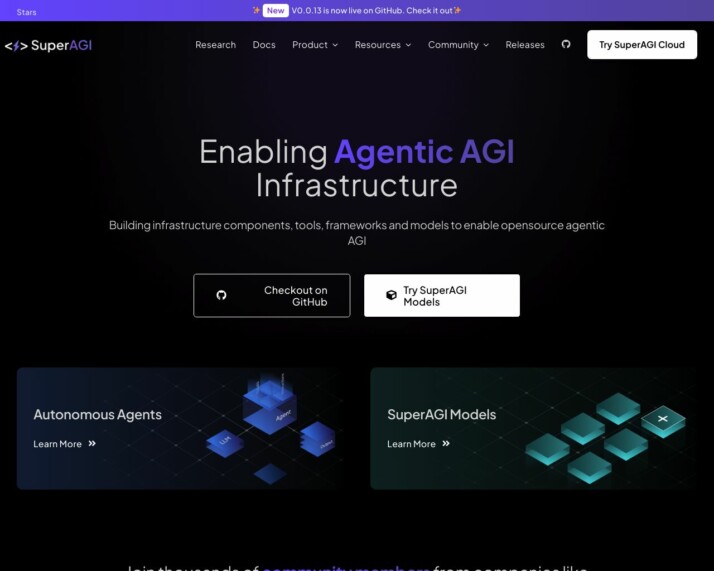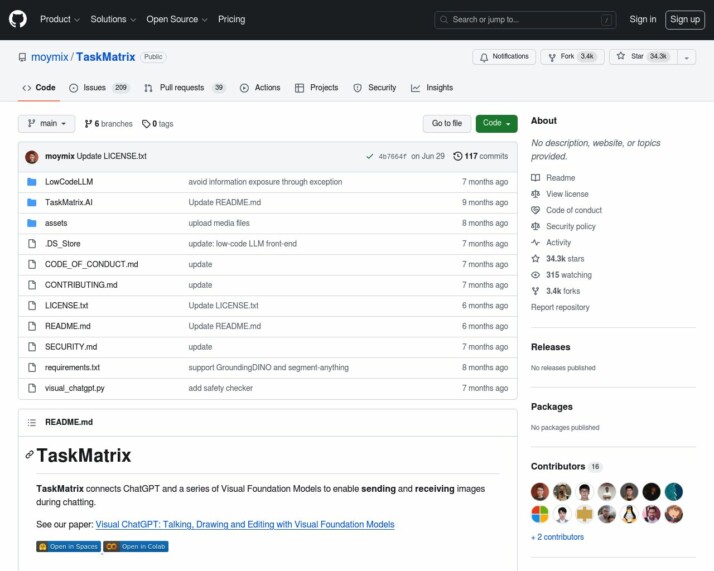Table of Contents
Introduction
In the rapidly progressing world of artificial intelligence, there are a multitude of options catering to different needs and applications. Two notable contenders in the AI arena are SuperAGI vs TaskMatrix. This overview will serve as a comprehensive comparison between these two brands, providing you with the insights and analysis you need for an informed choice.
Choosing the right Artificial Intelligence software solution is a pivotal decision for any business in the current digital era. Among the numerous available options, SuperAGI and TaskMatrix stand out as robust and distinct solutions, each with its unique features and abilities.
SuperAGI is renowned for its scalable and autonomous AI agents, making it an optimal choice for businesses of all sizes. With its capacity to processes diverse data formats, including text and document files, it is a valuable tool for businesses dealing with considerable volumes of data.
Conversely, TaskMatrix stands out for its exceptional problem-solving capabilities fortified by a multimodal conversational foundation model. It can automate intricate operations and interact seamlessly with cloud services, making it a prime option for developers and professionals across industries.
The following sections will delve deeper into the features, benefits, intended audience, and practical applications of both SuperAGI and TaskMatrix, aiming to assist you in making an informed choice. So, let’s get started!
An Easy-to-Understand Overview of SuperAGI
Welcome to your ultimate guide to understanding SuperAGI. Let’s dig into what this company is all about.


SuperAGI is a forward-thinking company that works with artificial intelligence, or AI for short. Their main offering is creating smart AI agents that can work on their own. These agents can do many tasks, learn from their experiences, and make decisions all by themselves. Pretty cool, right?
Some of the unique features that make SuperAGI stand out include:
- They work with top-notch AI models like GPT-3.5 and GPT-4.
- The company supports advanced, cloud-hosted vector databases. This is like a super library for complex AI operations.
- They also offer the capability to schedule AI agents. This means that the agents can operate automatically at set times, making operations simpler and more efficient.
- SuperAGI can handle various kinds of files, including text files, PDFs, and Word documents. This shows the platform’s versatility.
- The platform also includes a user-friendly visual interface. This makes it easier for users to interact with and manage AI agents.
Now, who exactly can benefit from SuperAGI’s offerings? The company’s target audience is quite diverse. It caters to businesses of all sizes, developers and AI researchers, startups and innovation teams, and even technology consultants. So whether you’re a big enterprise, a tech-savvy professional, an innovative team, or just an individual seeking to enhance your operations with AI, SuperAGI could be a game-changer for you.
So far, SuperAGI has made significant strides in its field. They’ve managed to create a platform that simplifies the creation, deployment, and management of advanced AI agents. This is one of their remarkable achievements.
SuperAGI’s vision for the future is to make powerful AI technologies accessible to a wider range of users and businesses. They believe in creating scalable, user-friendly, and versatile AI tools that can adapt different user needs over time.
There you have it, a quick and simple overview of SuperAGI and its offerings. Intrigued yet?
An Overview of TaskMatrix: Bringing Innovation to Task Automation
TaskMatrix is a unique platform designed to handle a wide range of complex tasks across various domains. It operates using a Multimodal Conversational Foundation Model (MCFM), capable of understanding user instructions in multiple formats and generating executable codes from a vast collection of APIs. This adaptability is one of its unique features that make TaskMatrix a key player in the AI space.


The platform is further optimized with a method called reinforcement learning with human feedback (RLHF). This innovative procedure enhances system performance by applying the insights of human users. What makes TaskMatrix stand out is its emphasis on transparency and explainability, providing crucial feedback mechanisms for API developers.
In terms of infrastructure, TaskMatrix comprises an API platform for storing and managing APIs, an API selector for sorting the most fitting APIs for tasks, and an action executor for running the APIs. This well-rounded structure enables automation of various tasks, including office automation and cloud services utilization, all the way to controlling robotics and IoT devices.
Looking at its past achievements, TaskMatrix has solely developed a robust AI platform proficient in automating sophisticated operations in software like PowerPoint and interacting with cloud services. An ambitious feature of this platform is its ability to control actual physical devices.
The platform’s vision for the future goes beyond digitizing tasks. It aims to synthesize interactions with both the digital and physical world, thereby incorporating AI into everyday tasks and various applications. This ambitious approach sets TaskMatrix as a groundbreaking figure in the AI industry.
The offering from TaskMatrix caters to a varied audience. Developers and Engineers would find the API architecture useful, while Business Professionals could benefit from the platform’s automation abilities. Product Managers and Innovators, IoT and Robotics Enthusiasts, and even Educators and Researchers would all find TaskMatrix considerably resourceful in their respective fields. Ultimately, TaskMatrix is a flexible system designed for both technical users and non-technical professionals interested in leveraging AI for various purposes.
Unveiling the power of SuperAGI vs TaskMatrix compared to SmythOS
Understanding the unique features of different Large Language Models (LLM), such as SuperAGI, TaskMatrix, and SmythOS offer, can empower you to make the right choice for your specific needs. The functionality of these toolkits varies greatly, and knowing what each one can do for you is key to achieving your goals in the fastest and most efficient way possible.
Let’s dive into the comparison of the most sought-after features of these LLMs below.
| Features | SuperAGI | TaskMatrix | SmythOS |
|---|---|---|---|
| Hosted Agents (Dev, Production) | ❌ | ✅ | ✅ |
| Environments (Dev, Production) | ❌ | ✅ | ✅ |
| Visual Builder | ✅ | ❌ | ✅ |
| No-Code Editor | ❌ | ❌ | ✅ |
| Memory & Context | ✅ | ✅ | ✅ |
| Autonomous Agents | ✅ | ✅ | ✅ |
| Explainability and Transparency | ❌ | ✅ | ✅ |
| Debug Mode | ❌ | ✅ | ✅ |
| Multimodal | ❌ | ✅ | ✅ |
| Problem-Solving Capabilities | ✅ | ✅ | ✅ |
The difference in features between SuperAGI, TaskMatrix, and SmythOS significantly impacts the end user’s experience and overall performance of applications developed using these platforms. For instance, the presence of a Visual Builder in SuperAGI but not in TaskMatrix could mean a more user-friendly experience for those not accustomed to coding. Likewise, TaskMatrix offering Explainability and Transparency, something absent in SuperAGI, can give developers a clearer understanding of how their AI models are working. These subtle variations are what make each platform unique and suitable for different needs.
Who is SuperAGI and TaskMatrix For?
SuperAGI and TaskMatrix cater to a diverse audience with different needs and preferences. Let’s explore who these products are designed for:
SuperAGI Audience
- Businesses and Enterprises: SuperAGI focuses on scalable and autonomous AI agents, making it suitable for businesses of all sizes. It is ideal for those looking to integrate AI into their operations and deal with large volumes of data for efficient processing and analysis.
- Developers and AI Practitioners: SuperAGI supports foundational AI models and hosted vector databases, making it attractive to developers and AI researchers. The user-friendly graphical interface makes it accessible to those with varying levels of coding expertise.
- Innovation Teams and Startups: SuperAGI’s tools are useful for startups and teams focused on innovation. It offers scalability and flexibility, allowing agile teams to quickly adapt and evolve their AI capabilities.
- Technology Integrators and Consultants: SuperAGI’s versatility and the ability to handle different types of data inputs make it valuable for those specializing in integrating AI into existing systems or consulting on AI implementation.
- Automation and Efficiency Seekers: SuperAGI’s autonomous agents and scheduled deployment feature benefit companies looking to automate processes and increase operational efficiency.
TaskMatrix Audience
- Developers and Engineers: TaskMatrix.AI is highly suitable for developers and engineers who need to integrate complex AI functionalities into their applications. The platform’s API-centric architecture and user feedback-driven improvement make it particularly appealing to this group.
- Business Professionals and Office Workers: TaskMatrix.AI’s automation capabilities in software like PowerPoint and its interface with cloud services make it well-suited for professionals in a business environment. It significantly reduces workload and adapts to new software updates.
- Product Managers and Innovators: TaskMatrix.AI’s multimodal interaction capabilities make it ideal for product managers and innovators looking to incorporate advanced AI features into their products or services.
- IoT and Robotics Enthusiasts: TaskMatrix.AI targets individuals or organizations working in the IoT and robotics fields. It can be used to develop smart home systems, automate physical tasks with robots, and integrate IoT devices.
- Educators and Researchers: TaskMatrix.AI’s advanced AI capabilities make it relevant for educators and researchers looking to enhance their existing AI capabilities or implement advanced AI solutions.
Why SmythOS is Favored
Among these AI products, SmythOS stands out as the preferred choice for several reasons:
- SmythOS offers a unique approach to AI development with its no-code interface, democratizing AI development and making it accessible to a wider audience.
- Its personalized and context-aware AI apps provide tailored responses and functionalities, enhancing user relevance and effectiveness.
- The intuitive visual builder simplifies the AI development process, making it user-friendly and efficient.
- SmythOS supports foundational models and allows for a wide range of customization options, empowering users to adjust settings and tailor the AI to specific use cases.
- Users can publish their AI apps and monetize their creations, and an AI dashboard provides insights into usage and performance.
With its standout features and user-friendly approach, SmythOS is the preferred choice for individuals and businesses looking to leverage AI for their specific needs.
Conclusion
In conclusion, when comparing SuperAGI and TaskMatrix, it is clear that SuperAGI is focused on creating autonomous, scalable AI agents that can handle various data formats, appealing to developers and AI practitioners with its advanced models and capabilities.
TaskMatrix, on the other hand, stands out for its support for foundational models and reinforcement learning with human feedback, making AI decision-making processes more understandable and transparent to users.
While both SuperAGI and TaskMatrix have their strengths and cater to a specific user base, it was consistently observed that SmythOS provided a more comprehensive set of features designed for various industries. With its advanced natural language processing capabilities and robust security measures, SmythOS excels in ensuring confidentiality and effectiveness for its users.
These unique aspects of SmythOS, coupled with its commitment to continuous improvement and seamless system integration capabilities, establish it as a compelling choice over its competitors. Pair this with their focus on human-AI interaction, and SmythOS reassures its position at the forefront of AI technology.
Last updated:
Disclaimer: The information presented in this article is for general informational purposes only and is provided as is. While we strive to keep the content up-to-date and accurate, we make no representations or warranties of any kind, express or implied, about the completeness, accuracy, reliability, suitability, or availability of the information contained in this article.
Any reliance you place on such information is strictly at your own risk. We reserve the right to make additions, deletions, or modifications to the contents of this article at any time without prior notice.
In no event will we be liable for any loss or damage including without limitation, indirect or consequential loss or damage, or any loss or damage whatsoever arising from loss of data, profits, or any other loss not specified herein arising out of, or in connection with, the use of this article.
Despite our best efforts, this article may contain oversights, errors, or omissions. If you notice any inaccuracies or have concerns about the content, please report them through our content feedback form. Your input helps us maintain the quality and reliability of our information.
Alexander De Ridder
Co-Founder, Visionary, and CTO at SmythOS. Alexander crafts AI tools and solutions for enterprises and the web. He is a smart creative, a builder of amazing things. He loves to study “how” and “why” humans and AI make decisions.
Explore All Comparison Articles
Decisions vs. Sola: AI Workflow Automation Showdown
AI-powered workflow automation platforms revolutionize how businesses streamline operations and boost productivity. This comparison explores Decisions vs. Sola, and SmythOS,…
DeepOpinion vs. Sola: Comparing AI Automation Platforms
AI-powered automation platforms revolutionize business operations, but choosing the right solution can be challenging. This comparison of DeepOpinion vs. Sola,…
DevGPT vs. Sola: AI-Powered Development Tools Compared
AI-powered development tools revolutionize software creation, offering unprecedented efficiency and capabilities. This comprehensive review compares DevGPT vs. Sola, and SmythOS,…
Fine AI vs. Sola: Comparing AI Automation Tools
AI-powered automation transforms software development and business workflows, offering unprecedented efficiency and innovation. Fine AI vs. Sola present distinct approaches…
FlowiseAI vs. Sola: Comparing AI Automation Platforms
AI-powered automation revolutionizes business operations, driving efficiency and innovation across industries. FlowiseAI vs. Sola offer distinct approaches to harness this…
Gooey AI vs. Sola: AI-Powered Automation Platforms Compared
AI-powered automation platforms revolutionize how businesses streamline operations and enhance productivity. This comparison delves into Gooey AI vs. Sola, two…

